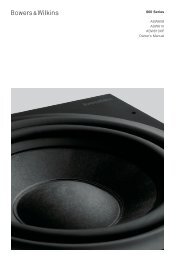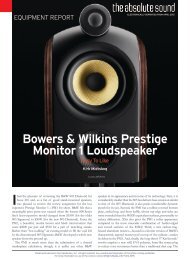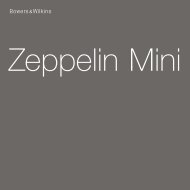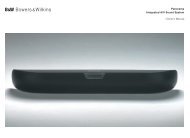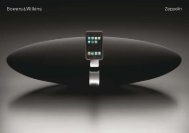CT8 XO Mk2 Manual - Bowers & Wilkins
CT8 XO Mk2 Manual - Bowers & Wilkins
CT8 XO Mk2 Manual - Bowers & Wilkins
Create successful ePaper yourself
Turn your PDF publications into a flip-book with our unique Google optimized e-Paper software.
60 o<br />
Figure 5<br />
Figure 7<br />
Figure 6<br />
~60 o<br />
Figure 6<br />
For optimum performance, it is important that the speakers are firmly and<br />
securely mounted. All the speakers may be mounted directly at floor level,<br />
but, as mentioned above, it can be beneficial to raise the position of the<br />
surround speakers and, if the screen is high, it may also be beneficial to<br />
do the same with the front speakers. In that case, the supporting structure<br />
for the speakers should be substantial. If constructed of wooden studding,<br />
the framework should be arranged to be directly beneath the feet of the<br />
speaker. (figure 6)<br />
All the speakers are equipped with roller glides on the base panel. These<br />
allow the speakers to be easily pushed into place in custom furniture. In<br />
order to position the speakers accurately, we suggest you create circular<br />
recesses 15mm (5/8 in) diameter in the support surface to locate the<br />
glides.<br />
To avoid rocking when the speakers are in position, it is<br />
important that these recesses are accurately positioned<br />
and a foot-positioning template is supplied for this<br />
purpose.<br />
The shaded area at the front of the template is to allow clearance for the<br />
movement of the bass cones. For the <strong>CT8</strong> DS, the side-firing drive units<br />
require free acoustic access into the listening room, indicated by the<br />
shaded area of the template extending round the sides. The <strong>CT8</strong> DS will<br />
normally have the front half of the cabinet protruding clear into the room.<br />
It may, however, be built in to a false pillar, but this must be acoustically<br />
transparent at the sides, as well as the front, as indicated by the shaded<br />
area.<br />
If the speakers are to be inset in a false wall, a front template is provided<br />
for guidance in cutting the aperture. The template is the same size as the<br />
speaker, so remember to leave some clearance. The height of the template<br />
includes the roller glides.<br />
If the speakers are to be mounted in custom furniture, you should also<br />
ensure that it is substantially built and not prone to induced vibration. It<br />
should be braced where necessary and it may be beneficial to glue<br />
bituminous damping pads, similar to those used in motor vehicles, to<br />
large unsupported panels. Such pads need to be thicker on wood than<br />
metal and a minimum of 6mm (1⁄4 in) should be used.<br />
If it is desired to remove the roller glides, use the Torx ® key supplied with<br />
the speaker to remove the retaining screws.<br />
An optional, spike foot kit is also available (Part No FP22359). The kit<br />
contains 4 heavy-duty feet that have 40mm (1.6 in) of vertical adjustment,<br />
allowing tilt up to 8 o if desired. This tilt is in addition to that offered by the<br />
adjustable head unit of the <strong>CT8</strong> LR and <strong>CT8</strong> CC.<br />
The feet are reversible, having a spike for carpets on one end and a rubber<br />
pad for vulnerable surfaces on the other. Fitting is most easily accomplished<br />
during unpacking, when the underside of the speaker is exposed.<br />
(figure 7)<br />
Mounting the Speakers<br />
9





